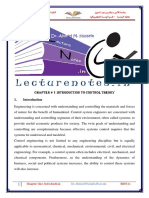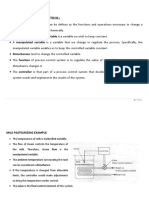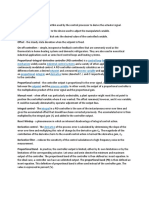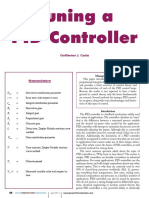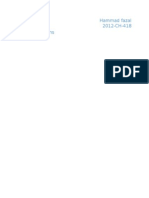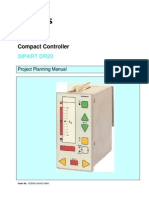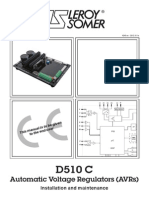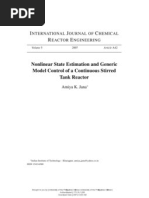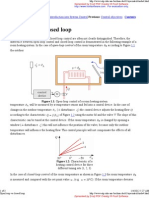Temperature Control Demonstration Unit: Experimental Setup
Temperature Control Demonstration Unit: Experimental Setup
Uploaded by
Hammad FazalCopyright:
Available Formats
Temperature Control Demonstration Unit: Experimental Setup
Temperature Control Demonstration Unit: Experimental Setup
Uploaded by
Hammad FazalOriginal Description:
Original Title
Copyright
Available Formats
Share this document
Did you find this document useful?
Is this content inappropriate?
Copyright:
Available Formats
Temperature Control Demonstration Unit: Experimental Setup
Temperature Control Demonstration Unit: Experimental Setup
Uploaded by
Hammad FazalCopyright:
Available Formats
Temperature control demonstration unit
Introduction
Temperature process rig uses
water as both a process fluid
and a secondary cooling circuit.
Rig comprises of a benchmounted temperature rig with
temperature
sensors,
process
interface and controllers.
Experimental setup
The system comprises two water
circuits. Named primary and
secondary, in the secondary circuit
fresh water from the tab is heated
up by a heat exchanger. The
temperature is measured by a
temperature sensor at the fresh
water outlet. The primary circuit
comprises an electrically heated
tank,
a
pump
and
an
electromagnetic proportional valve
as the actuator. Both circuits
include rotameters. The controller
used is a state-of-the-art digital industrial controller. A ball valve in the secondary
circuit enables defined disturbance variables to be generated. The outlet
temperature of the fresh water is controlled by the flow rate of warm water in the
primary circuit.
Theory
Proportional controller
In this control method, the control system acts in a way that the control effort is
proportional to the error. There is always a certain error in this controller type, called
steady state error
Integral Control.
In this control method, the control systems acts in a way that the control effort is
proportional to the integral of the error. The proportional controller amplifies the
error and applies a control effort to the system that is proportional to the error. In
integral control, the control effort is proportional to the integral of the error so the
controller now needs to be an integrator.
Proportional Integral Control
Integral control combined with proportional control gives us a controller which will
always act to maintain the controlled variable at its desired value. The proportional
control mode provides a stabilizing influence while the integral mode will
help to overcome the offset. Integral controller will provide corrective action as
long as there is a deviation in the controlled variable from the set point value.
Proportional Derivative Control
Derivative control action combined with proportional gives us a controller which is
good on processes containing appreciable lag. Because the process lag can be
compensated by the anticipatory nature of derivative action (i.e.) derivative action
provides the boost necessary to counter act the time delay associated with such
control systems. This is due to the fact that derivative control leads proportional
control by 90 deg. Since this controller combination is most effective where the
system lags are high, it could be used on most multi capacity process applications.
Proportional Integral Derivative Control
When all three control effects are combined together, we obtain the benefits of each
control action and moreover the effect duplicates the action of a good human
operator on a control application. A three mode controller contains the stability
to eliminate offset because of reset control and the ability to provide an
immediate correction for the magnitude of a disturbance because of rate control.
Differential Gap
Differential gap is the region in which the control causes the manipulated
variable to maintain its pervious value until the controlled variable has moved
slightly beyond the set point.
Time Delay
The delay given to the controller between successive corrective actions
Proportional Control
It is a controller action in which there is a continuous linear relation between value
of the controlled variable and position of the final control element with in the
proportional band.
Proportional Band
Proportional band or throttling range is defined as the percent deviation in
measurement of its full scale required to give 100% valve deviation.
Proportional Gain
It is the proportional control factor which is used to determine the proportional
band.
Proportional Band=100 of full scale valve/ proportional gain(Kp)
Experimental procedure
Turn on demonstration unit via main switch
Make sure cold(fresh) water circuit is off
Set a desired set point on controller
Using heater rise the temperature of water in tank up to a certain value
Open valve on cool water circuit to allow water to run into exchanger
Observe the value of outlet temperature of cool water after a certain interval
of time
Calculate inlet temperature of cool water by energy balance
Calculate area of heat exchanger
You might also like
- Building Management System - BMS 1Document31 pagesBuilding Management System - BMS 1jaffna100% (2)
- Lab 1 On Off ControllerDocument15 pagesLab 1 On Off ControllerVithursan ThangarasaNo ratings yet
- General EK (Control)Document22 pagesGeneral EK (Control)Maneesh100% (1)
- IloDocument17 pagesIloHammad Fazal100% (1)
- Introduction To Industrial Instrumentation and Process ControlDocument29 pagesIntroduction To Industrial Instrumentation and Process ControlAlexis John Rubio100% (1)
- CHEE319 Notes 2012 Lecture1Document51 pagesCHEE319 Notes 2012 Lecture1Irvine MupambaNo ratings yet
- Chapter 1 IntroductionDocument18 pagesChapter 1 IntroductionSśēmǾǿ ŔämáďañNo ratings yet
- To Process Control: Dr. Ahmed Kamal El-DINDocument21 pagesTo Process Control: Dr. Ahmed Kamal El-DINJooNo ratings yet
- Experiment No.1: Now Manually Move The AVS-1 Bar To Control The Flow Through The Valve in To The ContainerDocument16 pagesExperiment No.1: Now Manually Move The AVS-1 Bar To Control The Flow Through The Valve in To The ContainerfahadfiazNo ratings yet
- Mechatronics (1) .34 9Document57 pagesMechatronics (1) .34 9Anonymous p8bHAAxNo ratings yet
- Automatic Controllers & Control ModesDocument74 pagesAutomatic Controllers & Control ModesVishal IyerNo ratings yet
- ControlsDocument29 pagesControlsVinay PanditNo ratings yet
- Instrumentation and ControlDocument41 pagesInstrumentation and ControlAnonymous 5ZR8rH3No ratings yet
- General: P - A - R - TCDocument18 pagesGeneral: P - A - R - TCMohamed MosaedNo ratings yet
- Process FullDocument19 pagesProcess Fulljayashree sNo ratings yet
- Ind Process ControlDocument12 pagesInd Process ControlMamnoon Akhter SyedNo ratings yet
- W7ADocument15 pagesW7AShujah RashidNo ratings yet
- Why Do We Need Process ControlDocument6 pagesWhy Do We Need Process ControlSebastien Paul100% (2)
- Instrumentation Engineering Questions & AnswersDocument10 pagesInstrumentation Engineering Questions & AnswerscontgautamNo ratings yet
- PID Controller: Control Loop BasicsDocument6 pagesPID Controller: Control Loop Basicsdil17No ratings yet
- Process ControlDocument7 pagesProcess ControlVictor OuruNo ratings yet
- Processcontrol 170515171334Document13 pagesProcesscontrol 170515171334Coral Del Mar100% (1)
- PidDocument21 pagesPidSandesh Kumar B VNo ratings yet
- Control SystemDocument7 pagesControl SystemLeo LonardelliNo ratings yet
- IPCDocument15 pagesIPCu can't see meNo ratings yet
- ADPC Module 1Document23 pagesADPC Module 1Asif MohammedNo ratings yet
- Exp - P6 - Temperature ControlDocument10 pagesExp - P6 - Temperature ControlSiddesh PatilNo ratings yet
- PID Controller: Navigation SearchDocument8 pagesPID Controller: Navigation SearchprashantshivanagiNo ratings yet
- How A Control Valve Fixes Response Time 1689867528Document3 pagesHow A Control Valve Fixes Response Time 1689867528Warda YousafNo ratings yet
- Industrial Process Control Basic ConceptsDocument39 pagesIndustrial Process Control Basic Conceptskaezzar10100% (2)
- Temperature Control LabDocument16 pagesTemperature Control Labhoocheeleong234100% (1)
- PID ControllerDocument17 pagesPID Controlleradetag0% (1)
- Fundamentals of ControlDocument5 pagesFundamentals of Controltoony reyesNo ratings yet
- TminDocument17 pagesTminhanaNo ratings yet
- Unit 1 - Introduction: PretestDocument18 pagesUnit 1 - Introduction: Pretestariel mentawanNo ratings yet
- Laftah/15/ Azeez (HusseinDocument17 pagesLaftah/15/ Azeez (HusseinHadi. MNo ratings yet
- NI Tutorial 3782 enDocument4 pagesNI Tutorial 3782 enhiperboreoatlantecNo ratings yet
- NI Tutorial 3782 enDocument4 pagesNI Tutorial 3782 enpetergoodingNo ratings yet
- Process Control: University of Rizal SystemDocument21 pagesProcess Control: University of Rizal SystemJMNo ratings yet
- PID ControllersDocument58 pagesPID Controllerss12originalNo ratings yet
- PID ControlDocument11 pagesPID Controlhd03No ratings yet
- Summary For Chapter 8Document3 pagesSummary For Chapter 8Zeny NaranjoNo ratings yet
- Process ControlDocument2 pagesProcess ControlFakharAbbasNo ratings yet
- Unit 4Document9 pagesUnit 4720721107017No ratings yet
- Introductory Concepts: ErrorDocument5 pagesIntroductory Concepts: ErrorbismilishfaqNo ratings yet
- Control System PresentationDocument15 pagesControl System PresentationecegianNo ratings yet
- Department of Petrochemical Engineering College of Technical Engineering University of Polytechnic-DuhokDocument11 pagesDepartment of Petrochemical Engineering College of Technical Engineering University of Polytechnic-DuhokWalid AdnanNo ratings yet
- Control InstDocument481 pagesControl InstEnas Al-khawaldehNo ratings yet
- Process Control SystemsDocument6 pagesProcess Control SystemsRae angelo Agonoy100% (1)
- College of Engineering Process Control Lab.: Basrah UniversityDocument11 pagesCollege of Engineering Process Control Lab.: Basrah UniversityhanaNo ratings yet
- Tuning A PID Controller: Guillermo J. CostaDocument6 pagesTuning A PID Controller: Guillermo J. CostaDeepak RainaNo ratings yet
- Introduction To Process Automation - Process ControlDocument46 pagesIntroduction To Process Automation - Process ControlAli Asgerov100% (1)
- Temp Control Che LabDocument10 pagesTemp Control Che LabStephanie SomongcadNo ratings yet
- Experiment No 8 IC LabDocument12 pagesExperiment No 8 IC LabAyesha KhurramNo ratings yet
- Exp 66Document5 pagesExp 66Ahmad AlteeleNo ratings yet
- PID ControllerDocument18 pagesPID ControllerCheng Khie Chieh100% (1)
- Chapter 8 FTDocument40 pagesChapter 8 FTUthaiyavani RajendranNo ratings yet
- PC LabManual 2024Document44 pagesPC LabManual 2024sathavaravishal987No ratings yet
- Chapter 5 PDF RevisedDocument13 pagesChapter 5 PDF RevisedSnake EyeNo ratings yet
- Temperature Control: On-Off ControllerDocument9 pagesTemperature Control: On-Off Controllerdivyansh kashyapNo ratings yet
- RapbehDocument1 pageRapbehTristan SisonNo ratings yet
- Diagnosis and Robust Control of Complex Building Central Chilling Systems for Enhanced Energy PerformanceFrom EverandDiagnosis and Robust Control of Complex Building Central Chilling Systems for Enhanced Energy PerformanceNo ratings yet
- Control of DC Motor Using Different Control StrategiesFrom EverandControl of DC Motor Using Different Control StrategiesNo ratings yet
- Environmental Impact Assesment 2Document15 pagesEnvironmental Impact Assesment 2Hammad FazalNo ratings yet
- Humidity ChartDocument7 pagesHumidity ChartHammad FazalNo ratings yet
- Environmental Impact AssesmentDocument15 pagesEnvironmental Impact AssesmentHammad Fazal100% (1)
- Nano Particles Nano TechnologyDocument2 pagesNano Particles Nano TechnologyHammad FazalNo ratings yet
- Energy Engineering: Hammad Fazal 2012-CH-418Document6 pagesEnergy Engineering: Hammad Fazal 2012-CH-418Hammad FazalNo ratings yet
- For Me For Business: Prepaid Postpaid Mobile Internet Int'l RoamingDocument7 pagesFor Me For Business: Prepaid Postpaid Mobile Internet Int'l RoamingHammad FazalNo ratings yet
- Liquefied Natural GasDocument5 pagesLiquefied Natural GasHammad FazalNo ratings yet
- Energy Engineering: Topics Title and Contents Introduction To EnergyDocument2 pagesEnergy Engineering: Topics Title and Contents Introduction To EnergyHammad FazalNo ratings yet
- LABORATORY Manual Numerical AnalysisDocument47 pagesLABORATORY Manual Numerical AnalysisHammad FazalNo ratings yet
- Excel Lessons Advanced TimesheetDocument1 pageExcel Lessons Advanced TimesheetHammad FazalNo ratings yet
- Chapter-4 System Design 4.1 Modelling of SRMDocument15 pagesChapter-4 System Design 4.1 Modelling of SRMSree GaneshNo ratings yet
- ECNG 2005 Laboratory and Project Design 3: Department of Electrical & Computer EngineeringDocument5 pagesECNG 2005 Laboratory and Project Design 3: Department of Electrical & Computer EngineeringMarlon BoucaudNo ratings yet
- Technical Feedback EhtcDocument9 pagesTechnical Feedback EhtcPrashant Kumar ChoudharyNo ratings yet
- Feedback Control Systemsion IntroductionDocument29 pagesFeedback Control Systemsion Introductionzxzxzx207No ratings yet
- Thermostat Theory of Project ControlDocument10 pagesThermostat Theory of Project ControlJulius Chavene0% (1)
- PC-Sample QuestionsDocument24 pagesPC-Sample QuestionsHeather EllaineNo ratings yet
- Analog Process Control and SensorsDocument27 pagesAnalog Process Control and SensorsMark Paul Santin Ganzalino100% (1)
- Introduction To SimulinkDocument123 pagesIntroduction To SimulinkCristhianCoyoNo ratings yet
- DR20Document136 pagesDR20Daryl Asto MercadoNo ratings yet
- Leroy Somer D510C AVRDocument54 pagesLeroy Somer D510C AVRabuzer1981No ratings yet
- To Perform SIL and PIL Testing On Fast D PDFDocument4 pagesTo Perform SIL and PIL Testing On Fast D PDFgil lerNo ratings yet
- Chemical Engineering in Practice Second Edition - SamplerDocument99 pagesChemical Engineering in Practice Second Edition - SamplerMaria De J. ER100% (3)
- PID ControllerDocument10 pagesPID ControllerFarid HazwanNo ratings yet
- Development of Automated Agricultural Process Monitoring and Control Technology in An Enclosed SystemDocument7 pagesDevelopment of Automated Agricultural Process Monitoring and Control Technology in An Enclosed SystemIOSRjournalNo ratings yet
- Gear PumpDocument58 pagesGear Pumpsgupta_615796100% (6)
- Pid TuningDocument19 pagesPid TuningAsuh Rifqi Prihandana100% (1)
- Ijcre 2007 5 1Document18 pagesIjcre 2007 5 1christopher_guiraNo ratings yet
- GRT Institute of Engineering and Technology,: P.I.D.T.Bala Durai Kannan, Ap / Eee, GRT IetDocument12 pagesGRT Institute of Engineering and Technology,: P.I.D.T.Bala Durai Kannan, Ap / Eee, GRT IetDharani KumarNo ratings yet
- Open Loop Vs Closed LoopDocument3 pagesOpen Loop Vs Closed LoopDonny Priyo Wicaksono100% (1)
- Industrial Automation 4Document78 pagesIndustrial Automation 4Satyam SinghNo ratings yet
- LP Bypass SystemDocument7 pagesLP Bypass SystemJackSparrow86No ratings yet
- Chapter 2 Discrete Data Control SystemsDocument70 pagesChapter 2 Discrete Data Control SystemsAmruth Thelkar67% (3)
- Compare PLC and DCSDocument12 pagesCompare PLC and DCSeddiethehead1968100% (1)
- EPS TENT-B P1 CON 025 MainTurbine and BFPT Controller System v0.3Document21 pagesEPS TENT-B P1 CON 025 MainTurbine and BFPT Controller System v0.3marya050876No ratings yet
- Introducation To Linear Control SystemsDocument23 pagesIntroducation To Linear Control SystemsJahan ZaibNo ratings yet
- Canadian Institute of Mines Metallurgy and Petroleum Peru Branch ICM-PerúDocument68 pagesCanadian Institute of Mines Metallurgy and Petroleum Peru Branch ICM-PerúRicardo Castillo Ramirez100% (1)







